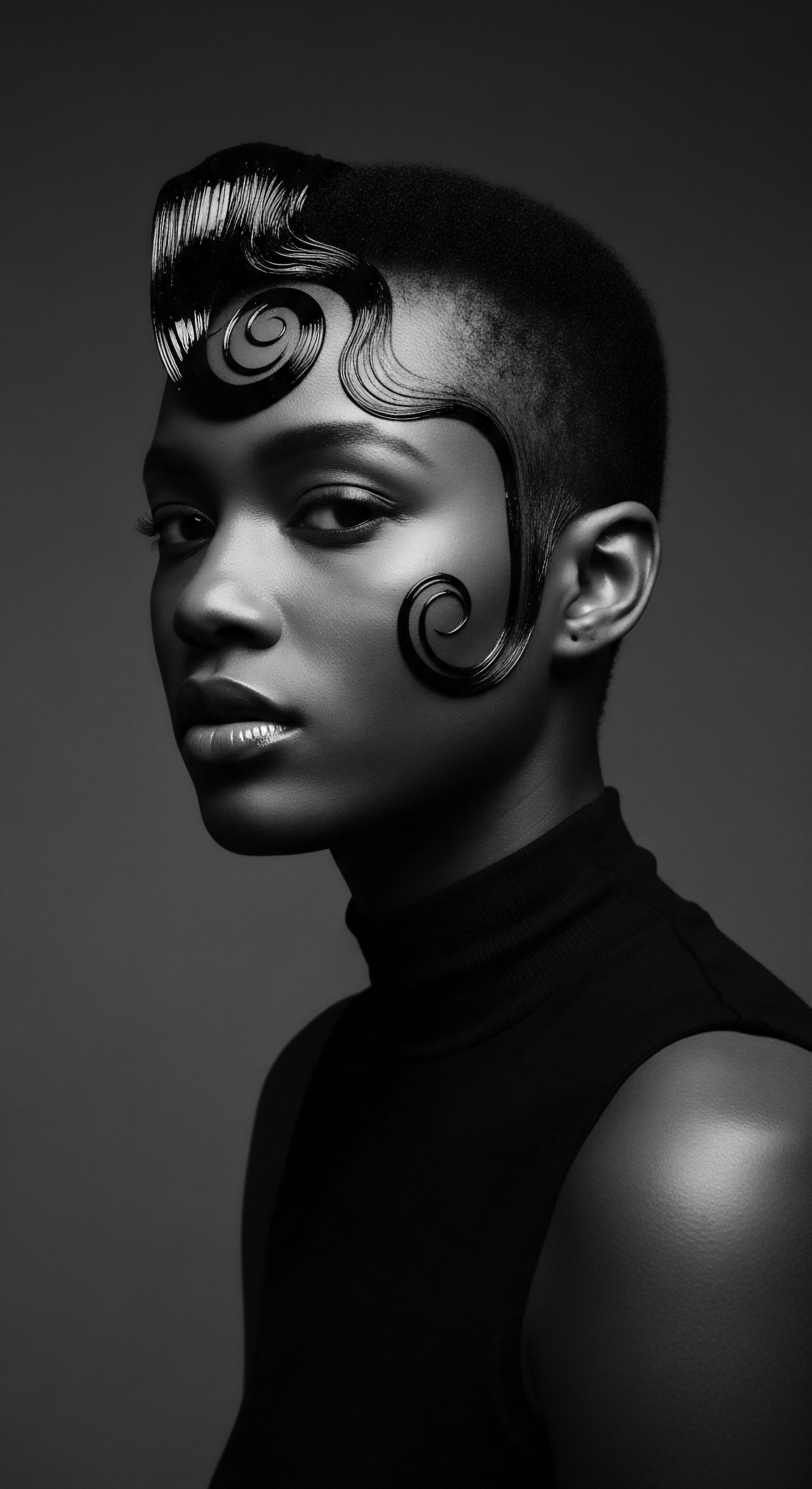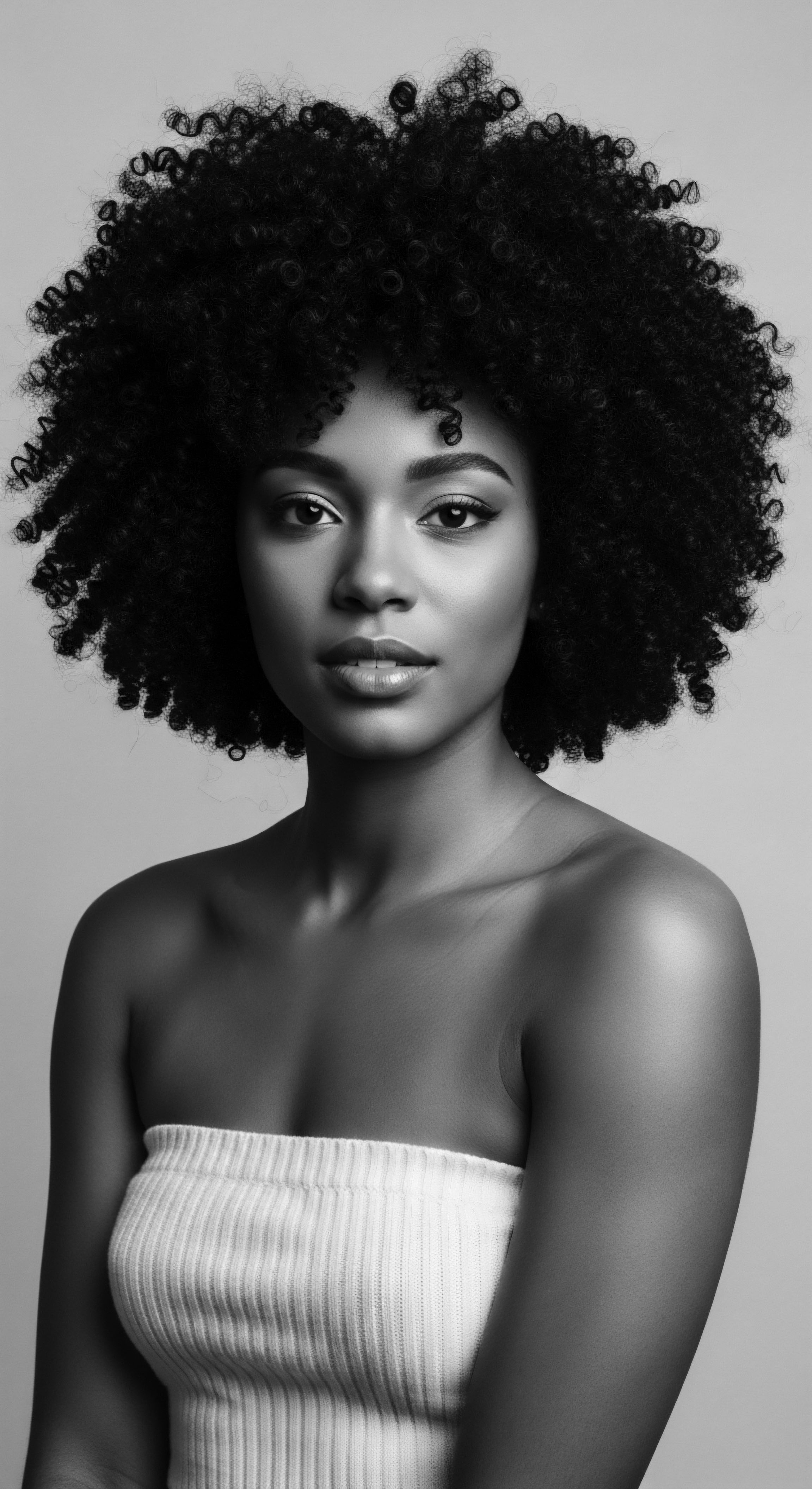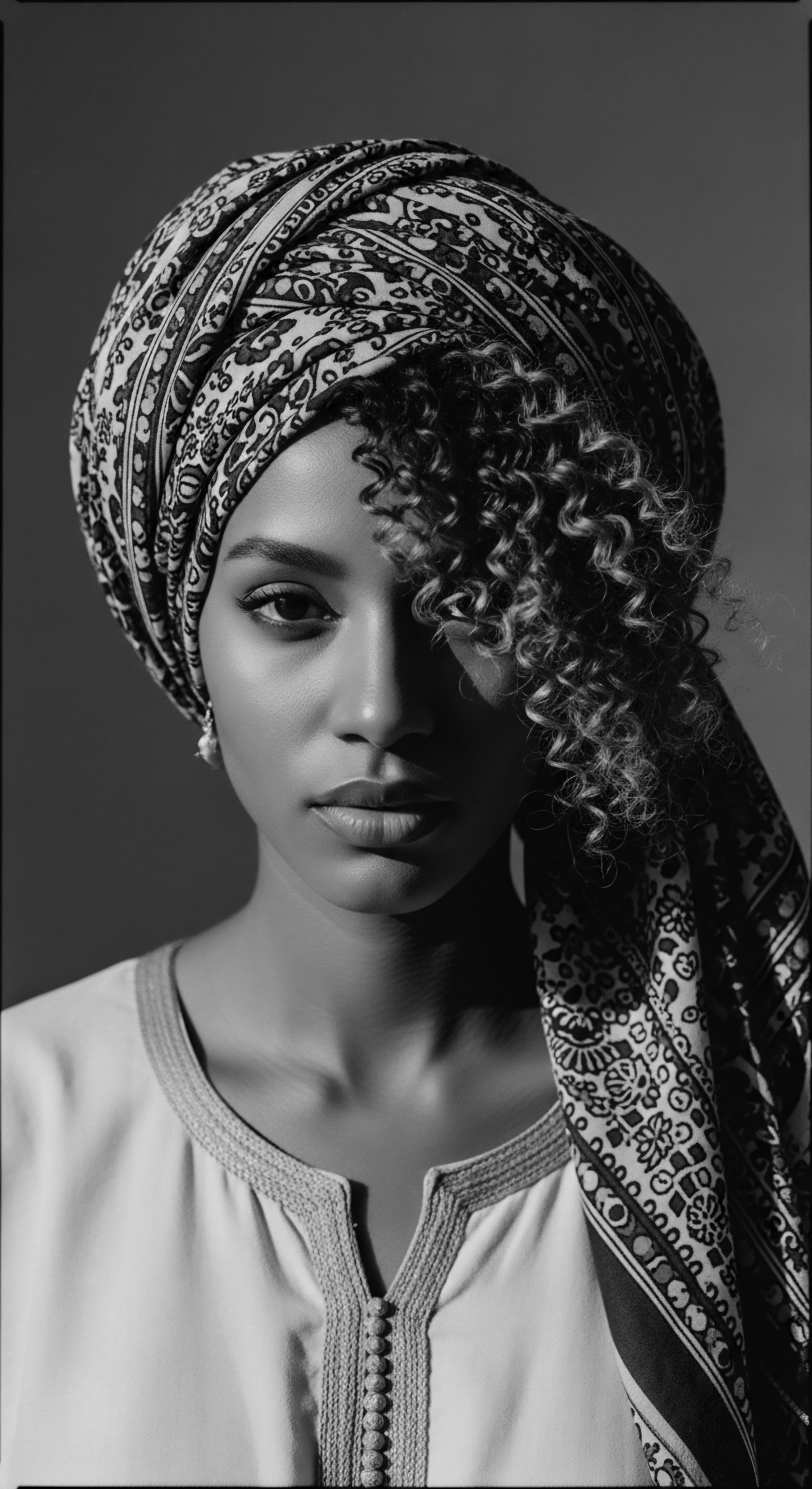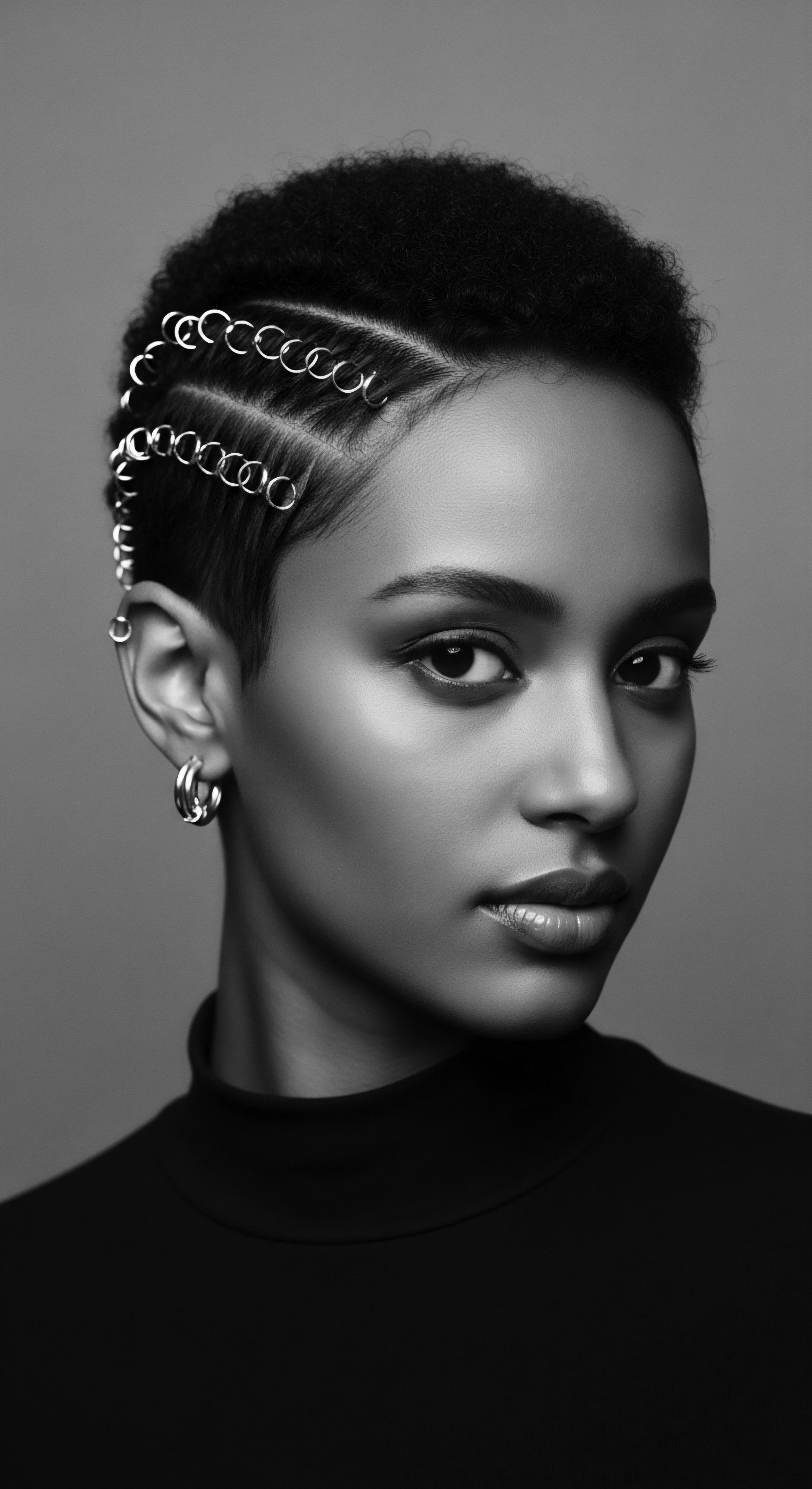
Roots
The very strands that crown our heads carry stories, echoes from long ago, whispered down through generations. For those with coils, kinks, and waves, hair is more than mere adornment; it serves as a living archive, a direct connection to ancestral wisdom, resilience, and identity. This journey into the potential benefits of henna for textured hair is not simply a scientific inquiry, a list of botanical attributes, but rather a deep honoring of a practice that spans continents and centuries. It invites us to consider how ancient traditions, once integral to daily life and ceremony, continue to hold relevance for contemporary well-being.
Consider the ancient wisdom keepers, those who knew the earth’s bounty intimately. They observed, experimented, and passed down knowledge about plants, discerning their properties for healing, beautification, and spiritual alignment. Henna, derived from the leaves of the Lawsonia Inermis shrub, stands as a testament to this ancestral ingenuity.
Its presence in hair care rituals reaches back over 5,000 years, gracing the locks of queens and commoners alike across North Africa, the Middle East, and South Asia. This history tells us that the value ascribed to henna extends beyond fleeting trends; it is rooted in profound, time-tested application.

What does Henna Bring to the Very Structure of Textured Hair?
At its core, textured hair possesses a distinctive helical structure, often elliptical in cross-section, with a cuticle layer that can be more prone to lifting. This natural conformation presents unique needs for moisture retention, strength, and elasticity. Modern science now explains how henna’s primary active compound, Lawsone (2-hydroxy-1,4-naphthoquinone), interacts with hair’s protein, keratin.
Lawsone molecules, when released from the plant material in a mildly acidic medium, bind to the keratin through a process called Michael addition. This molecular embrace creates a protective coating around each strand.
This bonding offers a form of reinforcement, a natural scaffolding for the hair shaft. For textured hair, which can sometimes exhibit areas of differing porosity along its length, this coating helps to smooth the outer cuticle. A smoother cuticle better retains moisture, reducing the likelihood of dryness and subsequent breakage, common challenges for many with coily and kinky patterns. The enhancement extends to improved hair texture, making it softer and more manageable.
The deep connection between ancient plant wisdom and modern hair science reveals a continuous legacy of care for textured hair.

How Did Hair Care Terms Arise from Heritage?
The lexicon surrounding textured hair has deep roots, often reflecting specific cultural practices and historical contexts. Terms like “kinky,” “coily,” and “wavy” describe the visual curl pattern, but the true depth of textured hair classification extends beyond mere shape. It speaks to density, porosity, and the unique ways these strands react to moisture and manipulation. Historically, communities developed their own descriptive words, often intertwined with social status, spiritual beliefs, and aesthetic ideals.
For example, in 15th century West Africa, a person’s hairstyle served as an identifier, communicating marital status, age, religion, and rank. The very act of caring for hair was a community event, a time for bonding and cultural transmission.
Understanding the properties of henna, therefore, connects us to this broader heritage of hair care nomenclature and practice. It shows us how a plant ingredient, revered for millennia, contributes to the very attributes that people seek in healthy, vibrant textured hair ❉ strength, sheen, and resilience. The continuous use of henna across generations underscores an intuitive grasp of its fortifying properties, long before laboratories could pinpoint lawsone or analyze its molecular interactions.
Consider the historical use of plant-based ingredients for hair wellness in African communities. For centuries, substances such as shea butter, coconut oil, and various clays, like rhassoul clay from Morocco, were used to nourish and cleanse hair. These remedies, often passed down through families, underscore a profound ancestral knowledge of nature’s offerings. The integration of henna into these historical practices, whether for ceremonial dyeing or as a general hair tonic, aligns with this tradition of seeking wellness from the earth.

Ritual
The path to understanding henna’s potential for textured hair leads us through the tender rituals of hair care, those practices born of both necessity and deep affection. For centuries, the tending of textured hair has served as a cultural anchor, a deliberate act that transcends mere personal grooming. It is a ceremony of continuity, a connection to the hands that came before us, and a proclamation of identity that has survived myriad challenges. Henna, in its journey from a humble plant to a revered beautifying agent, has found its way into many such rituals, shaping techniques and transforming strands.

How Has Henna Influenced Traditional Styling Practices?
In diverse African societies, from ancient Egypt to contemporary Sudan, henna has held a place within hair styling and adornment. Ancient Egyptians, for example, used henna to dye their hair, viewing it as a symbol of beauty and vitality. The very preparation of henna for application was, and remains, a ritual in itself, often involving specific mixing techniques and ceremonial timings. In Sudan, henna dyes carry a special sanctity and are present during joyful occasions such as weddings and circumcision ceremonies.
Brides and grooms alike historically applied henna to their hands and feet, with its use as a hair dye also documented. This communal aspect, often involving female relatives, highlights how henna application was a social bonding experience.
For textured hair, often celebrated in intricate styles like braids, twists, and cornrows, henna offers a unique contribution. These styles, which served as cultural markers indicating status, age, or marital standing, also functioned as protective measures. Henna’s strengthening properties support such protective styles.
It coats the hair, providing a layer that can help minimize friction and breakage that sometimes accompanies manipulation. This structural reinforcement means that strands are better equipped to endure the tension of braiding or twisting, making it a natural ally for these ancestral styling traditions.
| Historical Application Ceremonial Dyeing in Ancient Egypt for beauty and vitality. |
| Modern Parallel for Textured Hair Using henna for subtle coloration or to add reddish tones to grays. |
| Historical Application Hair Strengthening in traditional care regimens across Africa. |
| Modern Parallel for Textured Hair Applying henna as a conditioning treatment to fortify strands. |
| Historical Application Protective Coating for strands, as implicitly understood by historical users. |
| Modern Parallel for Textured Hair Leveraging henna to smooth the cuticle and reduce breakage in protective styles. |
| Historical Application Scalp Health improvement noted in ancient texts and practices. |
| Modern Parallel for Textured Hair Utilizing henna's antifungal and antibacterial properties for a healthier scalp. |
| Historical Application Henna's utility for textured hair continues its heritage from ancient beauty rites to current care practices. |

What are the Ancestral Roots of Protective Styling?
Protective styling is a cornerstone of textured hair care, with roots stretching back centuries in African communities. These styles were not solely about aesthetics; they served profound practical purposes ❉ protecting the hair from environmental elements, maintaining length, and reducing daily manipulation. The Himba women of Southern Africa, for example, traditionally apply a mixture of ground ochre, goat hair, and butter, known as Otjize, to their hair.
This paste protects against sun and insects, while also carrying deep cultural symbolism relating to land and ancestors. Similarly, African hair threading, known as Irun Kiko among the Yoruba people of Nigeria since the 15th century, was a method for length retention and protection.
Henna contributes to this legacy of protective styling by offering its unique properties. Its interaction with keratin, the protein that forms hair, creates a resilient outer layer. This can contribute to the longevity and structural integrity of braids, twists, and other styles that keep delicate ends tucked away.
The ability of henna to fortify hair makes it a suitable natural ally for those seeking to preserve the strength of their strands within protective styles. This aligns with historical practices that prioritized the structural health of hair, understanding that robust strands were foundational to both beauty and overall wellness.
The historical continuity of henna in hair rituals across African and diasporic communities underscores its enduring significance.
The ceremonial application of henna, particularly for brides in regions like Sudan, showcases its dual role ❉ a symbol of joy and blessings, alongside its practical use for enhancing hair and skin. These occasions were not merely about appearance; they were community gatherings, moments of shared female wisdom and preparation for significant life transitions. The detailed, intricate patterns applied with henna speak to a deep cultural artistry that celebrates both the individual and the collective heritage.
The versatility of henna also allowed it to be combined with other traditional ingredients. While pure henna yields a reddish-brown hue, it was sometimes combined with other plant materials, like indigo, to achieve different tones. This bespoke approach to natural hair coloring and care, drawing directly from the earth’s resources, reflects an ancestral understanding of natural chemistry and its practical application.

Relay
The transmission of ancestral practices across generations, a dynamic relay of wisdom, shapes our contemporary understanding of textured hair care. Here, the deep scientific grounding of henna’s interaction with hair structure meets the enduring cultural significance of its use within Black and mixed-race communities. This convergence allows us to see how elemental biology, long intuitively understood, finds validation in modern research, continuing a heritage of deliberate, affirming hair care.

How does Lawsone Interact with Keratin in Textured Hair?
The scientific dialogue around henna begins with lawsone, the principal reddish-orange pigment compound derived from the Lawsonia Inermis plant. When henna powder is mixed with a mildly acidic liquid, typically water or a weak tea, lawsone molecules are released. These molecules are small enough to penetrate the outermost layer of the hair, the cuticle, and bind directly to the keratin proteins within the hair shaft.
This chemical reaction, a Michael addition, creates a strong, permanent bond. The result is not merely a stain on the surface, but an integration into the hair’s very fabric, leading to color that lasts until the hair sheds.
For textured hair, this bonding process holds particular significance. Textured strands, due to their unique twists and bends, can sometimes have a more open or raised cuticle, making them prone to moisture loss and damage. The lawsone molecule, by binding to keratin and essentially coating the hair, acts as a reinforcing agent. This can help to smooth and seal the cuticle, improving the strand’s integrity.
A smoother cuticle means less friction between strands, potentially reducing tangles and breakage, and promoting enhanced shine and softness. This structural strengthening contributes to the overall resilience of the hair.
Studies confirm henna’s effects on hair health. For example, research indicates that henna possesses antifungal and antibacterial properties, which benefit scalp health. A healthy scalp is foundational for optimal hair growth and helps in reducing conditions like dandruff and irritation.
The presence of tannins and mucilage in henna leaves also contributes to its conditioning abilities, providing moisture and reducing breakage. This scientific validation aligns with centuries of anecdotal evidence and traditional practices that credit henna with improving hair vitality.

What Specific Ancestral Practices Validate Henna’s Scientific Benefits?
The collective wisdom of generations often precedes scientific dissection, offering powerful empirical validation. Across West Africa, for instance, traditional hair care involved the use of natural substances like shea butter, coconut oil, and various plant extracts to maintain moisture and strength. While not all communities directly used henna as a primary hair treatment, its widespread use for body adornment often coexisted with deep knowledge of local flora for hair care. The ritualistic care of hair itself, from intricate braiding sessions that served as community bonding to the use of specific oils, was an act of preserving ancestral knowledge and identity.
In the Basara Arab communities of Chad, West Africa, women are known for their exceptionally long, thick hair, achieved through the traditional use of Chebe Powder. This powder, a blend of herbs and seeds, is mixed with oils and applied to the hair to coat and protect it. While Chebe powder primarily promotes length retention by preventing breakage and locking in moisture, it provides a strong parallel to henna’s action.
Just as Chebe creates a protective coating, henna’s lawsone-keratin bond offers a similar, though chemically distinct, reinforcement. This demonstrates a consistent ancestral understanding that coating and protecting the hair shaft is fundamental to its long-term health and growth, particularly for kinky and coily textures.
The application of henna in regions like Sudan for both bridal hair preparation and general hair health, as recorded by researchers, provides a specific example of its historical efficacy. The practice of regularly applying henna to the hair, as observed in some communities, suggests an intuitive grasp of its fortifying effects, long before laboratory analyses revealed lawsone’s interaction with keratin. This continuous usage, passed down from mother to daughter, represents a living case study of henna’s benefits for textured hair.
Ancestral wisdom concerning plant properties for hair care, often passed down through generations, finds echoes in contemporary scientific discoveries about henna.
The chemical composition of henna, beyond just lawsone, includes tannins, flavonoids, and mucilage. These compounds are recognized for their antioxidant, antimicrobial, and conditioning properties. The mucilage, a gel-like substance, offers natural conditioning, making hair smoother and less prone to breakage, which is especially beneficial for textured hair that can be more susceptible to dryness.
The collective presence of these elements contributes to henna’s ability to improve scalp health, fortify strands, and impart shine. This understanding bridges the ancient appreciation for the plant’s efficacy with modern biochemical analysis.
The enduring practice of using henna, passed down through generations, holds profound lessons. It reveals a deep knowledge of natural ingredients and their applications, born from sustained observation and experience within specific ecological and cultural contexts. The transition of this knowledge, from oral traditions to written accounts and ultimately to scientific investigation, solidifies henna’s place as a uniquely beneficial substance for textured hair, rooted in a rich ancestral heritage.
- Lawsone ❉ The primary dye molecule in henna, responsible for bonding with hair keratin and imparting color.
- Tannins ❉ Plant compounds within henna that possess astringent properties, aiding in scalp toning and follicle health.
- Mucilage ❉ A gel-like substance present in henna leaves, providing natural conditioning and smoothing effects on hair strands.
The intricate relationship between henna and textured hair is not merely a matter of chemical reactions; it is a cultural continuum. The ancestral practices of hair care were often communal, fostering bonds and preserving shared identity. For instance, in West African societies, the act of braiding hair could span hours, serving as a time for storytelling and the transmission of social norms.
The addition of natural substances, including henna, into these long-standing care rituals was a way of honoring the hair as a sacred part of self, reflecting health, status, and community ties. This tradition holds meaning even today, as people with textured hair reclaim and celebrate natural care routines passed down through their lineage.

Reflection
As we gaze upon the intricate spirals and resilient coils of textured hair, we do not just see individual strands; we witness a living archive, a constant hum of ancestral memory. The exploration of henna’s contributions to this hair, from its botanical properties to its ceremonial applications, reaffirms a timeless truth ❉ the wisdom of those who came before us holds enduring relevance. This connection is the very Soul of a Strand, a testament to heritage that shapes not only our past but our vibrant present and unfolding future.
Henna, in its quiet power, reminds us that the quest for hair wellness is not a modern invention but a deeply inherited pursuit. It calls to mind the hands that carefully ground leaves, mixed pastes, and adorned heads in ancient lands, often under challenging circumstances. These were acts of survival, beauty, and cultural persistence.
The continuity of henna’s use, across continents and through the crucible of historical change, underscores the resilience of Black and mixed-race hair traditions. It is a symbol of self-acceptance, a reclaiming of practices that were sometimes dismissed or discouraged, now celebrated in their full, radiant authenticity.
In every application of henna, there is a whisper of continuity, a conscious decision to honor a lineage of care. The rich, earthy scent carries echoes of sun-drenched landscapes and communal gatherings. It is a tangible link to the ingenuity of our ancestors who understood, without microscopes or chemical analyses, the profound connection between the earth’s gifts and personal well-being.
This understanding moves beyond fleeting trends, instead grounding us in practices that have nourished hair and spirit for millennia. Our journey with henna, then, is not merely about hair appearance; it is a sacred reaffirmation of cultural identity, a continuation of a beautiful, unbroken story.

References
- Byrd, Ayana, and Lori L. Tharps. Hair Story ❉ Untangling the Roots of Black Hair in America. St. Martin’s Press, 2001.
- Danzarami, J. K. et al. “Phytochemical Screening of Henna Leaf Extracts (HLE) Using Water, Methanol, and Ethyl Acetate Methods.” Journal of Pharmacy and Chemical Biology, vol. 3, no. 1, 2016.
- El-Kamali, H. H. et al. “Chemical composition of Lawsonia inermis cultivated under Sudanese conditions-existence of chemotypes species.” International Journal of Pharmacy and Pharmaceutical Sciences, vol. 10, no. 1, 2018.
- Gallo, F. Multari, G. & Palazzino, G. “Traditional Henna Therapy & Cooling Effects in Egypt.” International Journal of Chemical and Biochemical Sciences, vol. 6, no. 3, 2018.
- Lalle, Anella, and Fudden ❉ Henna in West Africa. Eshkol HaKofer, 2016.
- Sharaby, Rachel. The Bride’s Henna Rituals ❉ Symbols, Meanings and Changes. Jerusalem Studies in Jewish Folklore, 2004.
- Simon, C. et al. “PHYTOCHEMICAL ANALYSIS AND INFLUENCE OF EDAPHIC FACTORS ON LAWSONE CONTENT OF LAWSONIA INERMIS L.” Update Publishing House, 1984.
